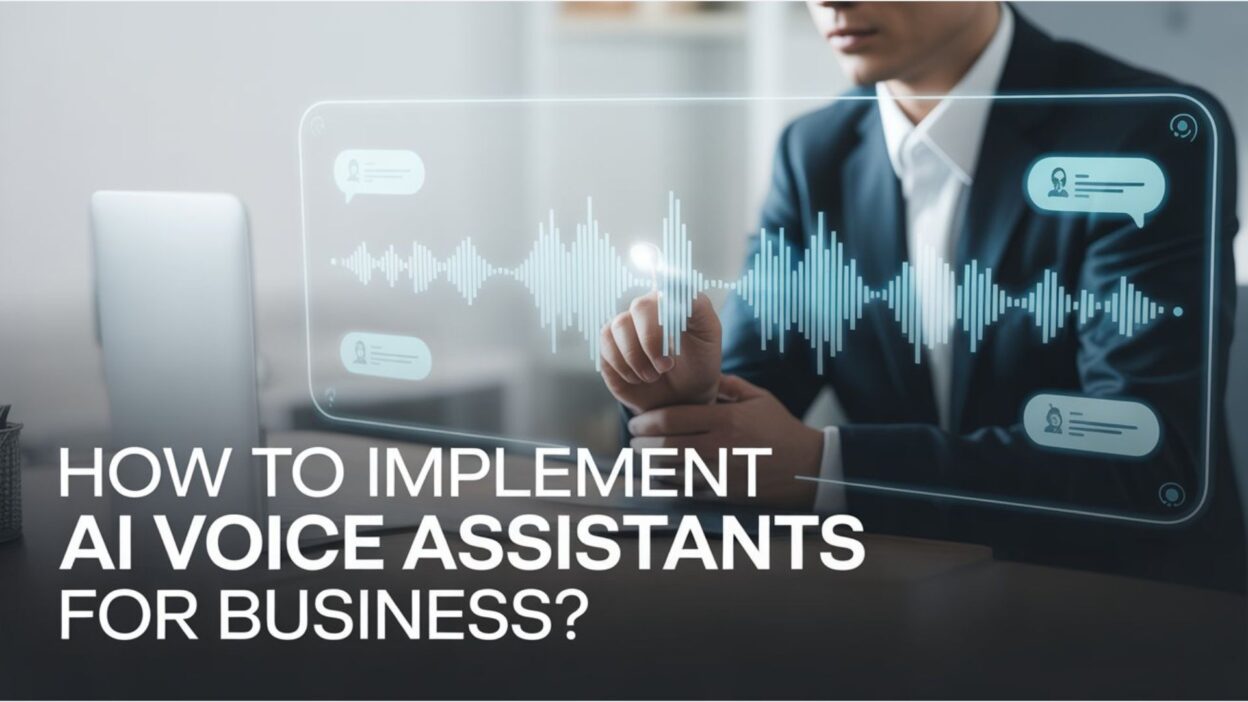TL;DR How to implement AI voice assistants for business communication has become a critical question for companies looking to streamline operations, enhance customer experiences, and stay ahead of the competition. With PreCallAI’s innovative voice AI technology, businesses can automate phone conversations while maintaining the personal touch customers expect.
Table of Contents
This comprehensive guide will walk you through everything you need to know about voice recognition software, from initial planning to successful deployment and optimization. Understanding voice recognition software effectively can transform your customer service operations and drive significant ROI.
Why Voice AI for Small Businesses is Essential
The landscape of company’s communication is rapidly evolving, and learning how to implement AI voice assistants for business communication is at the forefront of this transformation. Here’s why mastering cost reduction using automation is no longer optional but essential for modern businesses:
24/7 Customer Availability: Unlike human agents, AI voice assistants never sleep. When you understand cost reduction using automation, you can handle customer inquiries, schedule appointments, and process orders around the clock, ensuring your company never misses an opportunity.
Cost Efficiency: Implementing AI voice assistants for business communication can reduce operational costs by up to 80% compared to traditional call centers. With PreCallAI’s approach to implementing AI voice assistants for business communication, businesses can handle thousands of calls simultaneously without increasing staff.
Consistent Service Quality: Human agents can have bad days, but when you know cost reduction using automation properly, they deliver consistent, professional service every time. They don’t get tired, frustrated, or distracted, ensuring every customer receives the same high-quality experience.
Scalability: As your company grows, understanding cost reduction using automation allows them to easily scale to handle increased call volumes without the need for extensive hiring and training processes.
Data Collection and Insights: Every conversation with properly implemented AI voice assistants generates valuable data. When you master voice recognition software, this data can be analyzed to improve customer service, identify trends, and make informed company decisions.
Multilingual Support: Modern AI voice assistants can communicate in multiple languages, helping businesses expand their reach to diverse customer bases without hiring multilingual staff.
Implementing AI Voice Agents: A Step-by-Step Guide
Successfully learning voice recognition software requires careful planning and execution. Follow this comprehensive step-by-step guide on voice recognition software to ensure a smooth implementation process:
1. Define Your Purpose and Scope For How to Implement AI Voice Assistants for Business
Before diving into voice recognition software, clearly define what you want to accomplish. Understanding your communication starts with considering these key areas:
Primary Objectives: Determine whether your focus is on customer service, sales support, appointment scheduling, lead qualification, or a combination of these functions.
Call Volume Analysis: Analyze your current call patterns to understand peak hours, common inquiries, and areas where automation would be most beneficial.
Success Metrics: Establish clear KPIs such as call resolution rates, customer satisfaction scores, and cost savings to measure the success of your implementation.
Budget Allocation: Set realistic budgets for initial setup, ongoing maintenance, and potential scaling requirements.
2. Select the Right Technology Platform
Choosing the right AI voice assistant platform is crucial when learning voice recognition software. PreCallAI offers several advantages that make it the ideal choice for businesses exploring voice recognition software:
Advanced Natural Language Processing: PreCallAI uses cutting-edge NLP technology to understand customer intent and respond appropriately in natural conversations.
Easy Integration: The platform seamlessly integrates with existing CRM systems, scheduling tools, and business applications without disrupting current workflows.
Customizable Voice Options: Choose from various voice personalities and accents to match your brand identity and customer preferences.
Robust Analytics Dashboard: Monitor performance metrics, conversation logs, and improvement opportunities through comprehensive reporting tools.
Cloud-Based Infrastructure: Benefit from reliable, scalable cloud infrastructure that grows with your business needs.
3. Design Intuitive Conversational Flows
Creating effective conversational flows is essential when mastering how to API for voice assistants communication. Understanding voice user interface (VUI) design requires providing smooth customer experiences through:
Map Customer Journey: Document all possible customer interaction paths and create decision trees for different scenarios.
Script Development: Write natural, conversational scripts that sound human while efficiently guiding customers toward resolutions.
Fallback Options: Design clear escalation paths for complex issues that require human intervention.
Personalization Elements: Incorporate customer data to personalize interactions and improve engagement.
4. Build and Train Your AI Model
Training your AI voice assistant is a crucial part of implementing AI voice assistants for business communication. This ongoing process of voice user interface (VUI) design requires attention to detail:
Data Preparation: Compile historical call recordings, customer service logs, and frequently asked questions to train your AI model.
Intent Recognition Training: Teach the AI to recognize various customer intents and respond appropriately to different inquiry types.
Continuous Learning: Implement machine learning algorithms that allow the system to improve over time based on real interactions.
Voice Training: Fine-tune pronunciation, tone, and speaking pace to match your brand’s communication style.
5. Test Extensively Before Launch
Thorough testing is crucial when learning how to implement AI voice assistants for company. This critical step in cost reduction using automation ensures your AI speech assistant performs optimally:
Internal Testing: Conduct comprehensive internal testing with various scenarios and edge cases to identify potential issues.
Beta Testing: Run limited beta tests with select customers to gather real-world feedback and make necessary adjustments.
Performance Monitoring: Test system performance under different load conditions to ensure reliability during peak usage.
Quality Assurance: Verify that all conversational flows work correctly and that the AI responds appropriately to different customer inputs.
6. Integration and Deployment For How to Implement AI Voice Assistants for Business
Seamless integration with existing systems is essential when understanding API for voice assistants. This phase of how to implement API for voice agents focuses on operational efficiency:
CRM Integration: Connect your AI voice assistant with your CRM system to access customer data and update records automatically.
Phone System Integration: Ensure smooth integration with your current phone infrastructure or VoIP systems.
Database Connectivity: Establish secure connections to relevant databases for real-time information access.
Security Implementation: Implement robust security measures to protect customer data and ensure compliance with relevant regulations.
7. Launch, Monitor, and Continuously Improve
Post-launch optimization is key to long-term success:
Gradual Rollout: Consider a phased launch approach, starting with specific departments or customer segments.
Performance Monitoring: Continuously monitor key metrics such as call completion rates, customer satisfaction, and resolution times.
Regular Updates: Implement regular updates based on customer feedback and changing business needs.
Staff Training: Train your human agents to work effectively alongside AI voice assistants for seamless handoffs when necessary.
Implement AI Voice Assistants Today
Don’t wait to transform your business communication. PreCallAI makes it easy to implement AI voice assistants with our user-friendly platform and comprehensive support. Start your journey toward automated, efficient customer communication today.
Ready to Get Started? PreCallAI offers:
- Quick setup and deployment (often within days, not months)
- Comprehensive training and support
- Flexible pricing plans for businesses of all sizes
- Risk-free trial periods to test functionality
Customization: Making Voice AI Work for Your Specific Business
Every business has unique needs, and your AI voice assistant should reflect that. PreCallAI offers extensive customization options:
Industry-Specific Solutions: Whether you’re in healthcare, retail, real estate, or professional services, PreCallAI can be customized to handle industry-specific terminology and compliance requirements.
Brand Voice Matching: Customize the AI’s personality, tone, and communication style to align with your brand identity and customer expectations.
Workflow Integration: Seamlessly integrate with your existing business processes, from appointment scheduling to order processing and customer follow-ups.
Custom Scripts and Responses: Develop custom conversation flows that address your specific customer needs and business objectives.
Multi-Channel Support: Extend your AI voice assistant capabilities across multiple communication channels for a unified customer experience.
Measuring Success with ROI For How to Implement AI Voice Assistants for Business
Implementing AI voice assistants for business communication should deliver measurable results. Here’s how to track your return on investment:
Cost Savings Metrics:
- Reduced staffing costs for routine inquiries
- Decreased call handling time
- Lower training and onboarding expenses
- Reduced operational overhead
Performance Improvements:
- Increased call resolution rates
- Improved customer satisfaction scores
- Faster response times
- Higher conversion rates for sales inquiries
Business Growth Indicators:
- Increased capacity to handle more customers
- Expanded service hours without additional costs
- Improved lead qualification and conversion
- Enhanced customer retention rates
Operational Efficiency:
- Automated routine tasks
- Reduced human error rates
- Streamlined business processes
- Better resource allocation
General Implementation For How to Implement AI Voice Assistants for Business
While implementing AI voice assistants offers numerous benefits, businesses may face certain challenges. Here’s how to address common challenges with their solutions:
Obstacles: Customer Acceptance Solution: Gradually introduce AI voice assistants and always provide options for human interaction when needed. Focus on improving customer experience rather than replacing human agents entirely.
Problem: Technical Integration Fixes: Work with experienced providers like PreCallAI, who offer comprehensive integration support and have proven experience with various business systems.
Issue: Data Security Concerns Results: Implement robust security measures, ensure compliance with relevant regulations, and maintain transparent communication about data usage and protection.
Hurdles: Maintaining Conversational Quality Outcome: Continuously monitor and improve conversational flows based on customer feedback and interaction data. Regular training updates are essential.
Barrier: Handling Complex Inquiries Results: Design clear escalation paths to human agents for complex issues while continuously expanding the AI’s capabilities to handle more sophisticated requests.
Read More: How Do Small Businesses Choose The Best AI Voice Assistant
Conclusion

Implementing AI voice assistants for business communication is no longer a futuristic concept; it’s a present-day necessity for businesses looking to stay competitive and provide exceptional customer service. With PreCallAI’s advanced technology and comprehensive support, the implementation process becomes straightforward and rewarding.
The benefits are clear: improved efficiency, cost savings, enhanced customer satisfaction, and the ability to scale operations without proportional increases in staff.
Take action today and discover how PreCallAI can revolutionize your business communication. The future of customer service is here, and it speaks your language.





